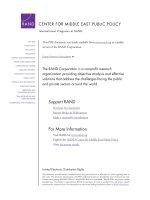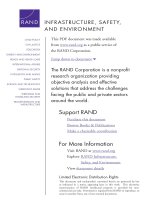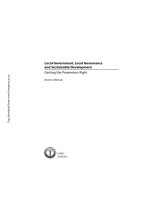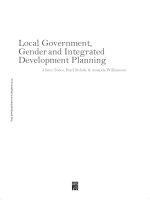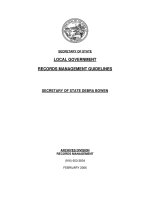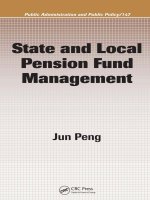State and Local Government Expenditures
Bạn đang xem bản rút gọn của tài liệu. Xem và tải ngay bản đầy đủ của tài liệu tại đây (209.16 KB, 54 trang )
Chapter 6
State and Local Government
Expenditures
Public Finance and Public Policy
Introduction
Optimal fiscal federalism
is the question of which
activities should take place at which level of
government.
For example, welfare programs were historically
financed at the federal and state level, while
education is largely financed at the state and local
level.
FISCAL FEDERALISM IN THE U.S.
AND ABROAD
Early in the history of the United States, the federal
government played a relatively limited role.
The last amendment of the Bill of Rights of the
United States Constitution states:
“The powers not delegated to the United States by the
Constitution, nor prohibited by it to the states, are
reserved to the states respectively, or to the people.”
Figure 1
Figure 1 shows the spending patterns over time.
Breakdown of Total Government Spending
0%
20%
40%
60%
80%
100%
1902
1927
1952
1977
2002
Share of Total Government Spending
Federal State Local
In 1902, the federal government
accounted for only 34% of total
government spending; local
governments accounted for 58%.
Federal government was responsible
for national defense, foreign
relations, judicial functions, and the
postal service.
State and local governments were
responsible for education, police,
roads, sanitation, welfare, health,
hospitals, and so on.
The role of the federal government
grew with the introduction of the
federal income tax and the New Deal
programs of the Great Depression.
The share of state financing coming
from the federal government has
grown because of joint program like
cash welfare and Medicaid.
Figure 1
FISCAL FEDERALISM IN THE U.S.
AND ABROAD
The largest element of state and local spending is
education, followed by health care and public safety.
For federal spending, the largest elements are health
care, Social Security, and national defense.
Spending and Revenue of State and Local
Governments
The major source of revenue at the state and local
level is the
property tax
, the tax on land and any
building on it.
Property taxes raised $253 billion in revenue in
2001, and accounted for almost one-half of the non-
grant revenues of local governments.
Fiscal Federalism Abroad
The U.S. sub-national governments collect a much
larger share of total government revenue than in
other countries, and spend a somewhat larger share
of total government spending.
Table 1
Table 1 shows this.
Table 1
Subnational government spending/revenue as a
share of total government spending/revenue
Spending % Revenue %
Greece 5.0 3.7
Portugal 12.8 8.3
France 18.6 13.1
Norway 38.8 20.3
United States 40.0 40.4
Denmark 57.8 34.6
OECD Average 32.2 21.9
The average state/local government
collects 22% of total government
revenue, while those in the U.S.
collect 40%.
On the spending side, the
differences are slightly less
dramatic.
Fiscal Federalism Abroad
The higher level of centralization in other nations
exists because state/local governments have almost
no legal power to tax citizens.
Many countries practice
fiscal equalization
,
whereby the national government distributes grants
to sub-national government in an effort to equalize
differences in wealth.
Fiscal Federalism Abroad
There has been a move toward decentralization
around the world.
In the U.S., there have been increased efforts to
shift control and financing of public programs to
the states, such as with welfare reform in 1996.
OPTIMAL FISCAL FEDERALISM
What is the optimal division of responsibilities
across different levels of government?
A theory of how the efficiency of public goods
provision may differ at different levels of
government helps answer this questions.
OPTIMAL FISCAL FEDERALISM
Two of the major problems in public goods
provision are:
Preference revelation: Difficult to design democratic
institutions to cause individuals to reveal their
preferences honestly.
Preference aggregation: Difficult to aggregate individual
preferences into a social decision.
The Tiebout Model
Tiebout (1956) showed that the inefficiency in
public goods provision came from two missing
factors: shopping and competition.
Shopping induces efficiency in private markets.
Competition induces the right prices and quantities
in private markets.
The Tiebout Model
With public goods provided at the local level,
competition naturally arises because individuals can
vote with their feet by moving to another town without
much disruption.
This induces fiscal discipline for local governments
and creates a new preference revelation device: mobility.
Tiebout argued that the threat of exit can induce
efficiency in local public goods production.
Under certain (unrealistic) conditions public goods
provision will be fully efficient at the local level.
The Tiebout Model
Tiebout’s formal model assumes the following:
Large number of individuals, who divide themselves
up across towns that provide different levels of
public goods.
Town i has N
i
residents who all demand G
i
of the
public good.
Uniform tax of G
i
/N
i
.
The Tiebout Model
Tiebout’s model solves two problems:
Preference revelation: There is no incentive to lie.
With a uniform tax on all residents, the consumer
saves 1/N
i
in tax but receives 1/N
i
less of the public
good.
Preference aggregation is solved because everyone in
the town wants the same level of public goods, G
i
.
Problems with the Tiebout Model
There are a number of problems with the model,
however, related to:
Tiebout competition
Tiebout financing
Spillovers
Problems with the Tiebout Model
Tiebout competition may not hold because:
It requires perfect mobility.
It requires perfect information on the benefits
individuals receive and the taxes they pay.
It requires enough choice of towns so that
individuals can find the right levels of public goods.
Problems with the Tiebout Model
Tiebout financing is problematic because:
It requires
lump-sum taxes
that are independent of
a person’s income. This is viewed as highly
inequitable.
It is more common for towns to finance public
goods through proportional taxes on homes, leading
to the problem of the poor chasing the rich.
The use of
zoning
can ameliorate this problem.
Problems with the Tiebout Model
Zoning regulations protect the tax base of wealthy
towns by pricing lower income individuals out of
the housing market.
For example, a town that prohibits multifamily
dwelling such as apartments lowers the available
amount of housing, and thus inflates the value of
existing housing, keeping the poor out.
Problems with the Tiebout Model
Tiebout model is also problematic because of the
assumption of no externalities or spillovers:
Model assumes public goods only have effects in a
given town, and that they do not spill over to
neighboring towns.
Some public goods, like a public park, probably
violate this assumption.
Evidence on the Tiebout Model
Even given the problems of the Tiebout model the
basic intuition that individuals vote with their feet is
still a strong one. Two types of tests reveal this:
Resident similarity
Capitalization
Evidence on the Tiebout Model
A clear prediction of the Tiebout model is that
residents in a local community will have similar
preferences for local public goods.
The more local communities and choices, the more
residents can sort themselves into similar groupings.
Gramlich and Rubenfeld (1982) found greater
sorting in larger metropolitan areas (where mobility
costs would be smaller), and greater satisfaction with
public goods provision.
Evidence on the Tiebout Model
Very little actual mobility is required for the Tiebout
mechanism to operate because people not only vote
with their feet.
They also vote with their pocketbook.
Tiebout model predicts that any differences in fiscal
attractiveness will be
capitalized into house
prices
.
Evidence on the Tiebout Model
That is, the price of any house reflects the costs
(including local property taxes) and benefits
(including local public goods) of living there.
Holding taxes constant, higher levels of public
goods raise housing prices.
Hold public good levels constant, raising taxes
lowers housing prices.
Housing prices are a reflection of people voting with
their pocketbook.

